Civil Engineering: Sustainability and Professional Practice Report
VerifiedAdded on 2020/04/29
|5
|1074
|87
Report
AI Summary
This report analyzes a civil engineering project focused on sustainable practices, specifically the design of compost bins for a community. The student details their contribution to the project, which involved researching the environmental impact of the design, including potential risks and mitigation strategies. The report also examines the team's dynamics, highlighting effective communication strategies, challenges faced (such as communication barriers and lack of commitment), and solutions implemented to improve collaboration and project outcomes. The student reflects on their role in the team, emphasizing the importance of active participation, attentive listening, and constructive criticism. The report concludes with a discussion of the team leader's role in organizing discussions, assigning tasks, setting deadlines, and ensuring active participation from all members. References used are also listed at the end of the report.
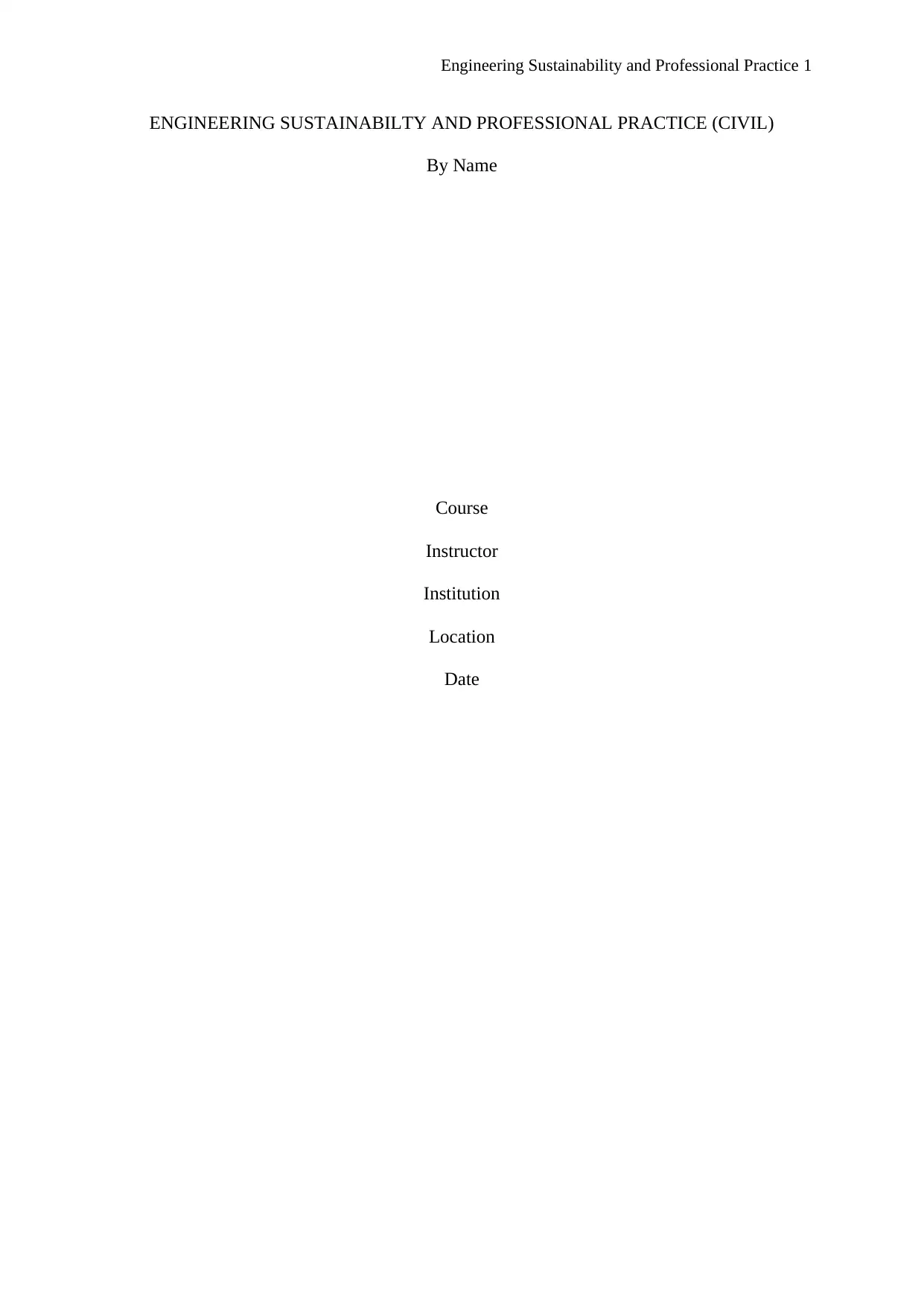
Engineering Sustainability and Professional Practice 1
ENGINEERING SUSTAINABILTY AND PROFESSIONAL PRACTICE (CIVIL)
By Name
Course
Instructor
Institution
Location
Date
ENGINEERING SUSTAINABILTY AND PROFESSIONAL PRACTICE (CIVIL)
By Name
Course
Instructor
Institution
Location
Date
Paraphrase This Document
Need a fresh take? Get an instant paraphrase of this document with our AI Paraphraser
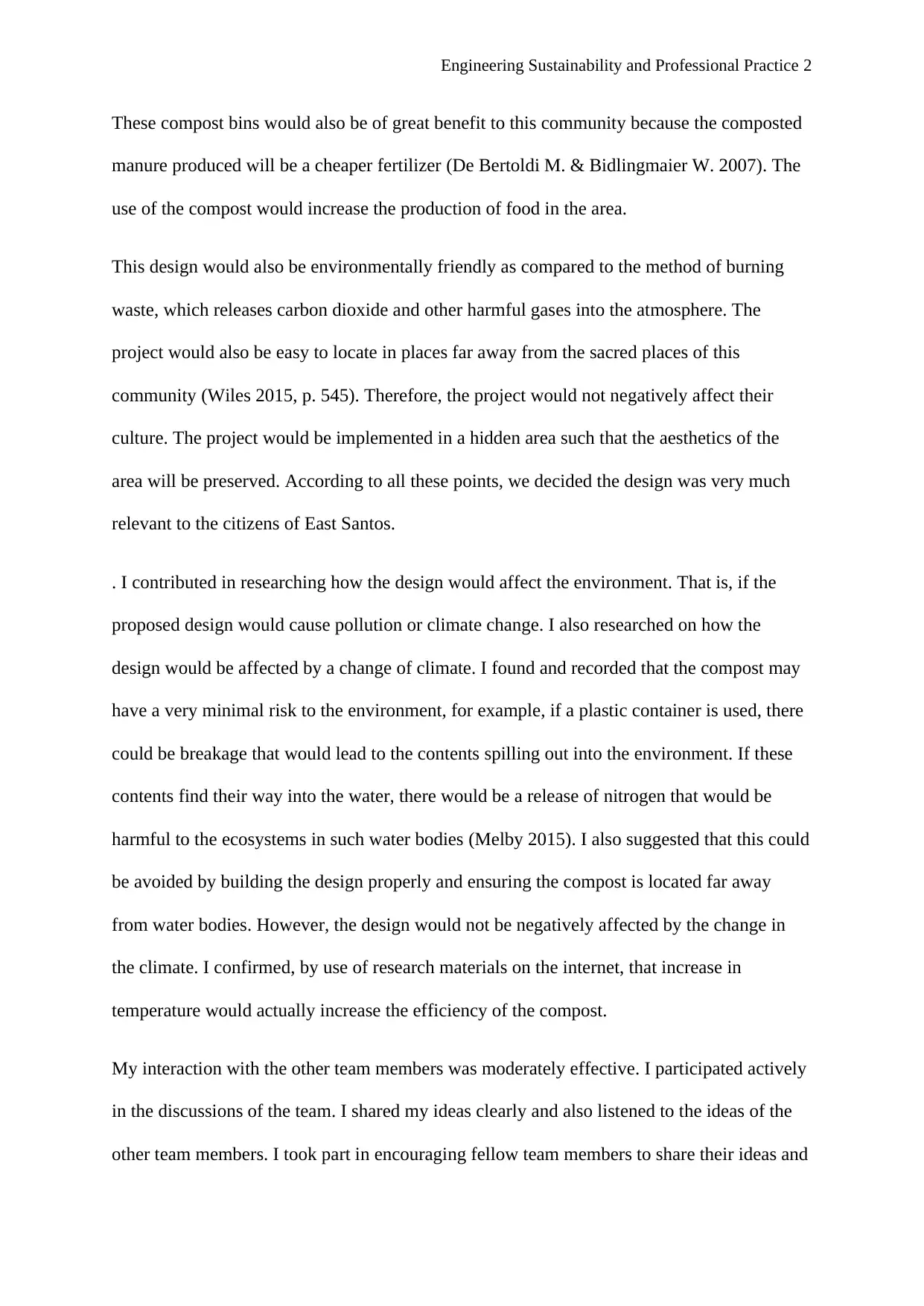
Engineering Sustainability and Professional Practice 2
These compost bins would also be of great benefit to this community because the composted
manure produced will be a cheaper fertilizer (De Bertoldi M. & Bidlingmaier W. 2007). The
use of the compost would increase the production of food in the area.
This design would also be environmentally friendly as compared to the method of burning
waste, which releases carbon dioxide and other harmful gases into the atmosphere. The
project would also be easy to locate in places far away from the sacred places of this
community (Wiles 2015, p. 545). Therefore, the project would not negatively affect their
culture. The project would be implemented in a hidden area such that the aesthetics of the
area will be preserved. According to all these points, we decided the design was very much
relevant to the citizens of East Santos.
. I contributed in researching how the design would affect the environment. That is, if the
proposed design would cause pollution or climate change. I also researched on how the
design would be affected by a change of climate. I found and recorded that the compost may
have a very minimal risk to the environment, for example, if a plastic container is used, there
could be breakage that would lead to the contents spilling out into the environment. If these
contents find their way into the water, there would be a release of nitrogen that would be
harmful to the ecosystems in such water bodies (Melby 2015). I also suggested that this could
be avoided by building the design properly and ensuring the compost is located far away
from water bodies. However, the design would not be negatively affected by the change in
the climate. I confirmed, by use of research materials on the internet, that increase in
temperature would actually increase the efficiency of the compost.
My interaction with the other team members was moderately effective. I participated actively
in the discussions of the team. I shared my ideas clearly and also listened to the ideas of the
other team members. I took part in encouraging fellow team members to share their ideas and
These compost bins would also be of great benefit to this community because the composted
manure produced will be a cheaper fertilizer (De Bertoldi M. & Bidlingmaier W. 2007). The
use of the compost would increase the production of food in the area.
This design would also be environmentally friendly as compared to the method of burning
waste, which releases carbon dioxide and other harmful gases into the atmosphere. The
project would also be easy to locate in places far away from the sacred places of this
community (Wiles 2015, p. 545). Therefore, the project would not negatively affect their
culture. The project would be implemented in a hidden area such that the aesthetics of the
area will be preserved. According to all these points, we decided the design was very much
relevant to the citizens of East Santos.
. I contributed in researching how the design would affect the environment. That is, if the
proposed design would cause pollution or climate change. I also researched on how the
design would be affected by a change of climate. I found and recorded that the compost may
have a very minimal risk to the environment, for example, if a plastic container is used, there
could be breakage that would lead to the contents spilling out into the environment. If these
contents find their way into the water, there would be a release of nitrogen that would be
harmful to the ecosystems in such water bodies (Melby 2015). I also suggested that this could
be avoided by building the design properly and ensuring the compost is located far away
from water bodies. However, the design would not be negatively affected by the change in
the climate. I confirmed, by use of research materials on the internet, that increase in
temperature would actually increase the efficiency of the compost.
My interaction with the other team members was moderately effective. I participated actively
in the discussions of the team. I shared my ideas clearly and also listened to the ideas of the
other team members. I took part in encouraging fellow team members to share their ideas and
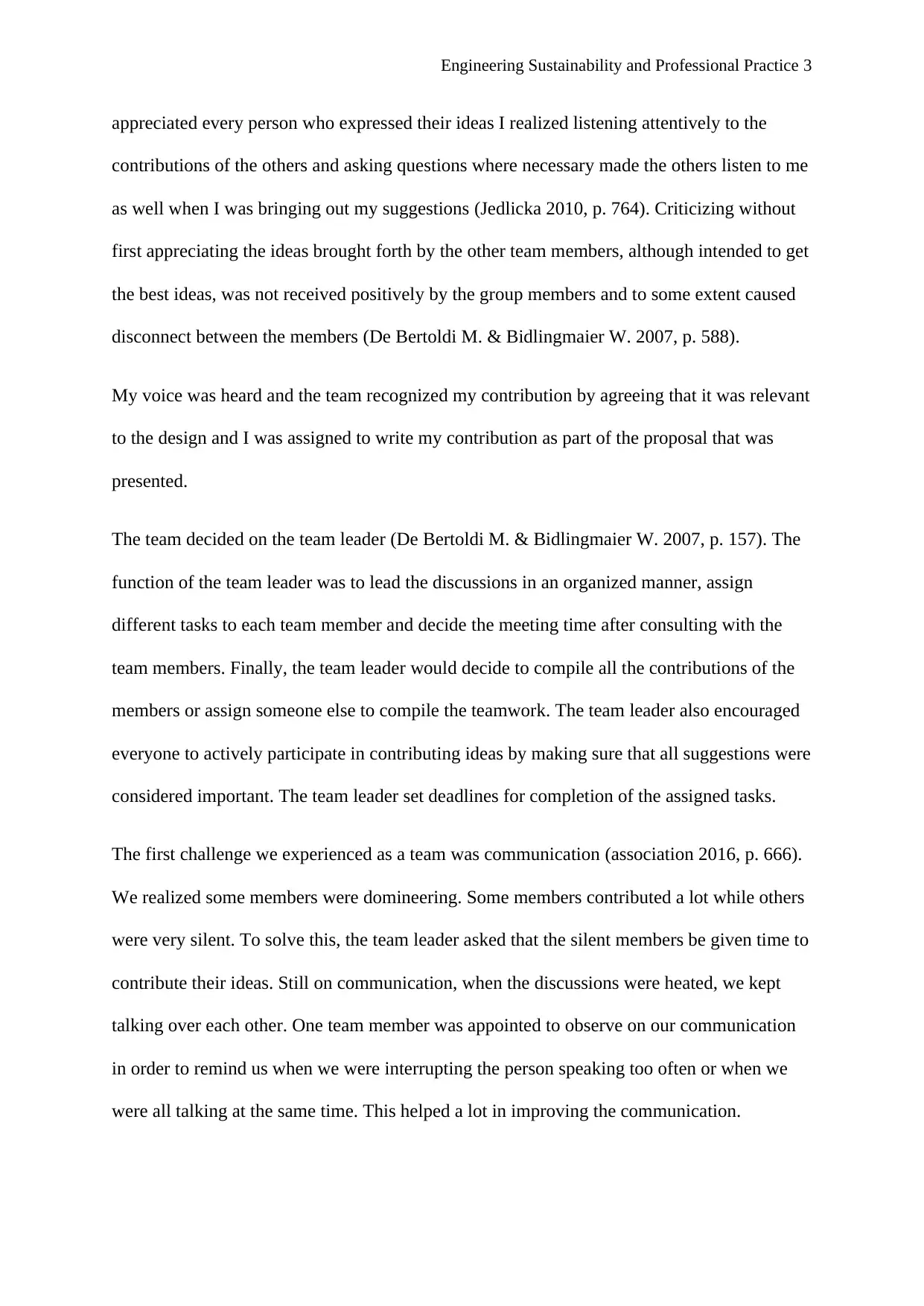
Engineering Sustainability and Professional Practice 3
appreciated every person who expressed their ideas I realized listening attentively to the
contributions of the others and asking questions where necessary made the others listen to me
as well when I was bringing out my suggestions (Jedlicka 2010, p. 764). Criticizing without
first appreciating the ideas brought forth by the other team members, although intended to get
the best ideas, was not received positively by the group members and to some extent caused
disconnect between the members (De Bertoldi M. & Bidlingmaier W. 2007, p. 588).
My voice was heard and the team recognized my contribution by agreeing that it was relevant
to the design and I was assigned to write my contribution as part of the proposal that was
presented.
The team decided on the team leader (De Bertoldi M. & Bidlingmaier W. 2007, p. 157). The
function of the team leader was to lead the discussions in an organized manner, assign
different tasks to each team member and decide the meeting time after consulting with the
team members. Finally, the team leader would decide to compile all the contributions of the
members or assign someone else to compile the teamwork. The team leader also encouraged
everyone to actively participate in contributing ideas by making sure that all suggestions were
considered important. The team leader set deadlines for completion of the assigned tasks.
The first challenge we experienced as a team was communication (association 2016, p. 666).
We realized some members were domineering. Some members contributed a lot while others
were very silent. To solve this, the team leader asked that the silent members be given time to
contribute their ideas. Still on communication, when the discussions were heated, we kept
talking over each other. One team member was appointed to observe on our communication
in order to remind us when we were interrupting the person speaking too often or when we
were all talking at the same time. This helped a lot in improving the communication.
appreciated every person who expressed their ideas I realized listening attentively to the
contributions of the others and asking questions where necessary made the others listen to me
as well when I was bringing out my suggestions (Jedlicka 2010, p. 764). Criticizing without
first appreciating the ideas brought forth by the other team members, although intended to get
the best ideas, was not received positively by the group members and to some extent caused
disconnect between the members (De Bertoldi M. & Bidlingmaier W. 2007, p. 588).
My voice was heard and the team recognized my contribution by agreeing that it was relevant
to the design and I was assigned to write my contribution as part of the proposal that was
presented.
The team decided on the team leader (De Bertoldi M. & Bidlingmaier W. 2007, p. 157). The
function of the team leader was to lead the discussions in an organized manner, assign
different tasks to each team member and decide the meeting time after consulting with the
team members. Finally, the team leader would decide to compile all the contributions of the
members or assign someone else to compile the teamwork. The team leader also encouraged
everyone to actively participate in contributing ideas by making sure that all suggestions were
considered important. The team leader set deadlines for completion of the assigned tasks.
The first challenge we experienced as a team was communication (association 2016, p. 666).
We realized some members were domineering. Some members contributed a lot while others
were very silent. To solve this, the team leader asked that the silent members be given time to
contribute their ideas. Still on communication, when the discussions were heated, we kept
talking over each other. One team member was appointed to observe on our communication
in order to remind us when we were interrupting the person speaking too often or when we
were all talking at the same time. This helped a lot in improving the communication.
⊘ This is a preview!⊘
Do you want full access?
Subscribe today to unlock all pages.

Trusted by 1+ million students worldwide
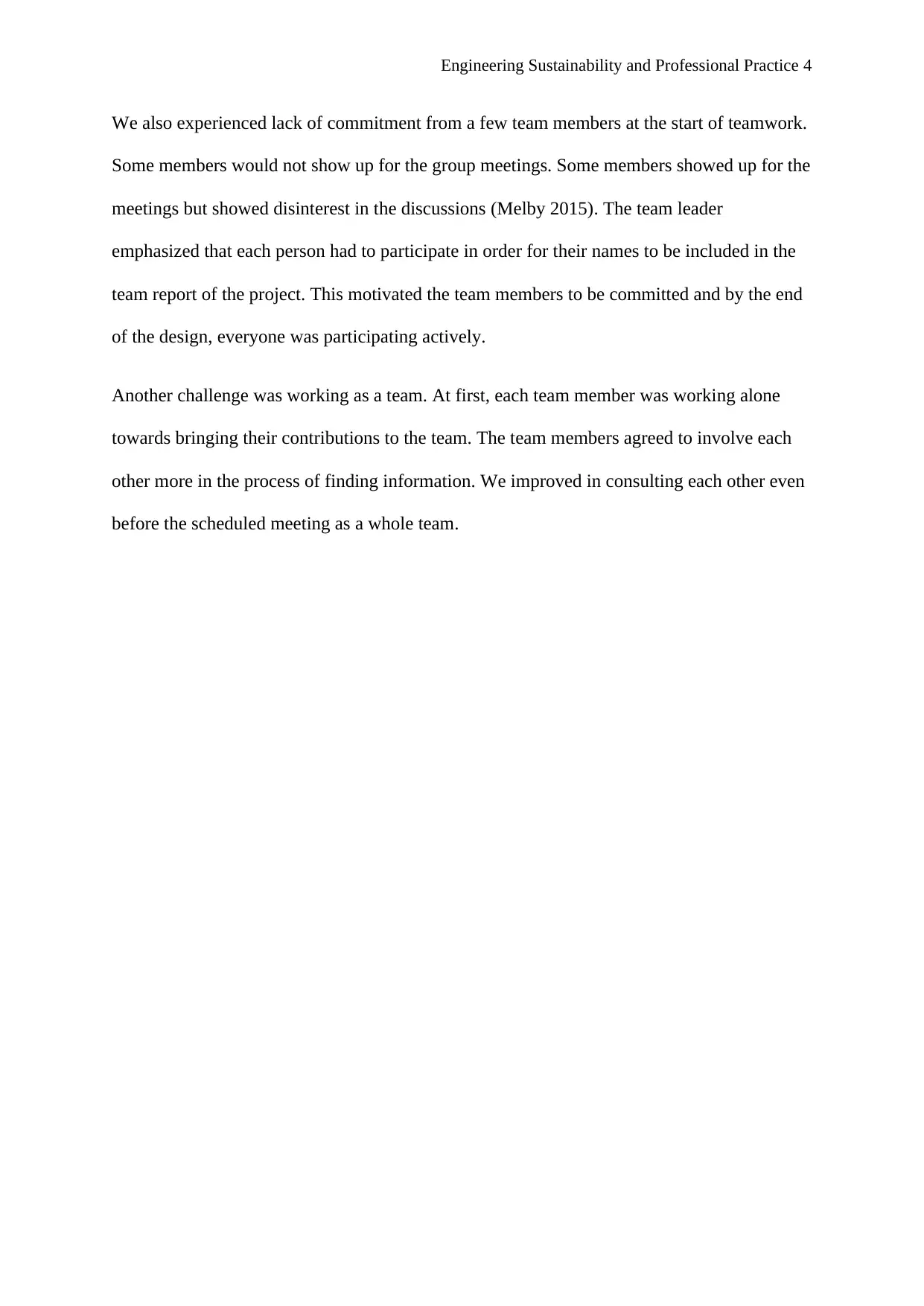
Engineering Sustainability and Professional Practice 4
We also experienced lack of commitment from a few team members at the start of teamwork.
Some members would not show up for the group meetings. Some members showed up for the
meetings but showed disinterest in the discussions (Melby 2015). The team leader
emphasized that each person had to participate in order for their names to be included in the
team report of the project. This motivated the team members to be committed and by the end
of the design, everyone was participating actively.
Another challenge was working as a team. At first, each team member was working alone
towards bringing their contributions to the team. The team members agreed to involve each
other more in the process of finding information. We improved in consulting each other even
before the scheduled meeting as a whole team.
We also experienced lack of commitment from a few team members at the start of teamwork.
Some members would not show up for the group meetings. Some members showed up for the
meetings but showed disinterest in the discussions (Melby 2015). The team leader
emphasized that each person had to participate in order for their names to be included in the
team report of the project. This motivated the team members to be committed and by the end
of the design, everyone was participating actively.
Another challenge was working as a team. At first, each team member was working alone
towards bringing their contributions to the team. The team members agreed to involve each
other more in the process of finding information. We improved in consulting each other even
before the scheduled meeting as a whole team.
Paraphrase This Document
Need a fresh take? Get an instant paraphrase of this document with our AI Paraphraser
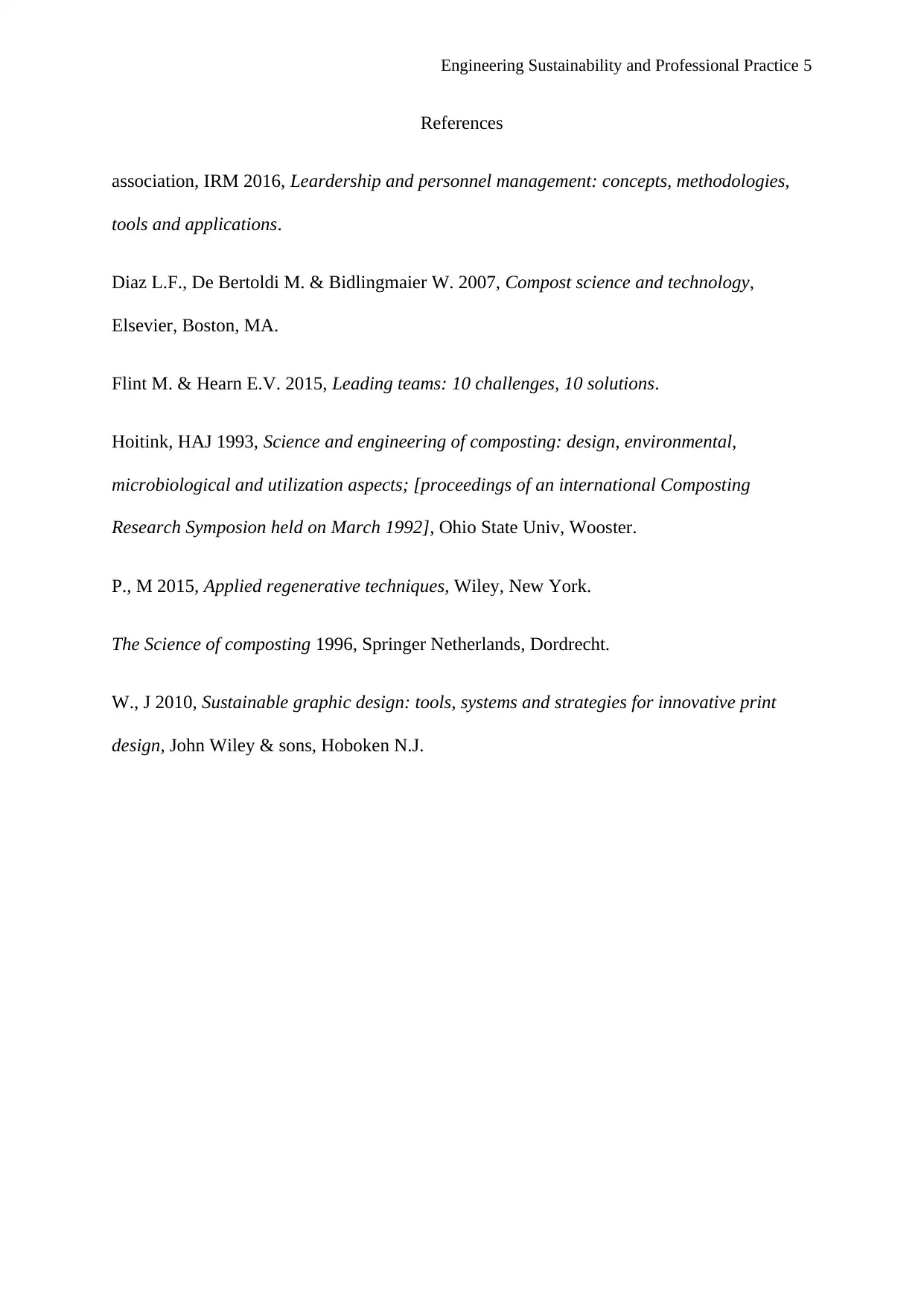
Engineering Sustainability and Professional Practice 5
References
association, IRM 2016, Leardership and personnel management: concepts, methodologies,
tools and applications.
Diaz L.F., De Bertoldi M. & Bidlingmaier W. 2007, Compost science and technology,
Elsevier, Boston, MA.
Flint M. & Hearn E.V. 2015, Leading teams: 10 challenges, 10 solutions.
Hoitink, HAJ 1993, Science and engineering of composting: design, environmental,
microbiological and utilization aspects; [proceedings of an international Composting
Research Symposion held on March 1992], Ohio State Univ, Wooster.
P., M 2015, Applied regenerative techniques, Wiley, New York.
The Science of composting 1996, Springer Netherlands, Dordrecht.
W., J 2010, Sustainable graphic design: tools, systems and strategies for innovative print
design, John Wiley & sons, Hoboken N.J.
References
association, IRM 2016, Leardership and personnel management: concepts, methodologies,
tools and applications.
Diaz L.F., De Bertoldi M. & Bidlingmaier W. 2007, Compost science and technology,
Elsevier, Boston, MA.
Flint M. & Hearn E.V. 2015, Leading teams: 10 challenges, 10 solutions.
Hoitink, HAJ 1993, Science and engineering of composting: design, environmental,
microbiological and utilization aspects; [proceedings of an international Composting
Research Symposion held on March 1992], Ohio State Univ, Wooster.
P., M 2015, Applied regenerative techniques, Wiley, New York.
The Science of composting 1996, Springer Netherlands, Dordrecht.
W., J 2010, Sustainable graphic design: tools, systems and strategies for innovative print
design, John Wiley & sons, Hoboken N.J.
1 out of 5
Your All-in-One AI-Powered Toolkit for Academic Success.
+13062052269
info@desklib.com
Available 24*7 on WhatsApp / Email
![[object Object]](/_next/static/media/star-bottom.7253800d.svg)
Unlock your academic potential
Copyright © 2020–2025 A2Z Services. All Rights Reserved. Developed and managed by ZUCOL.
